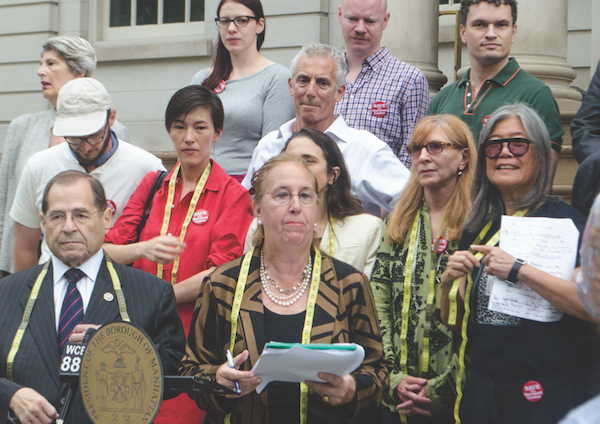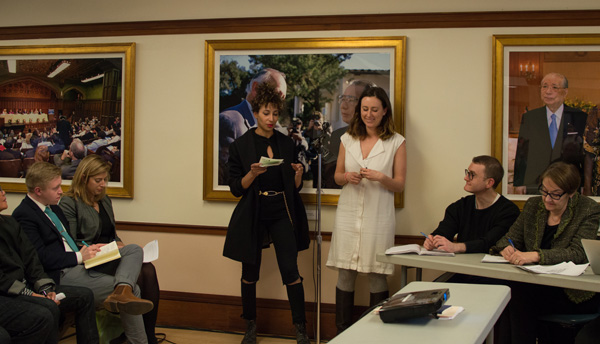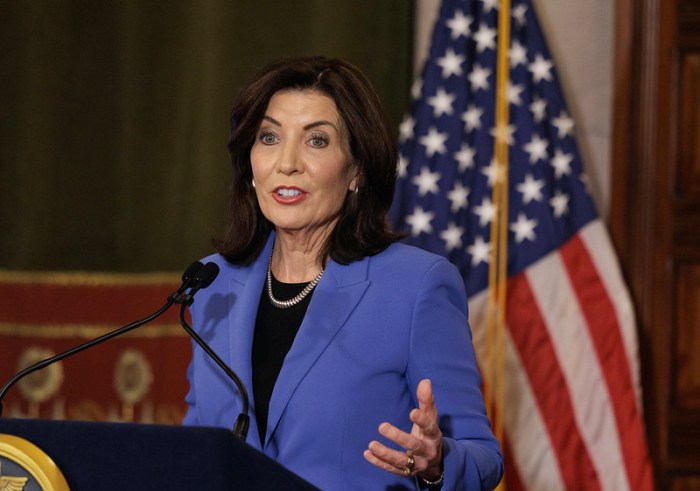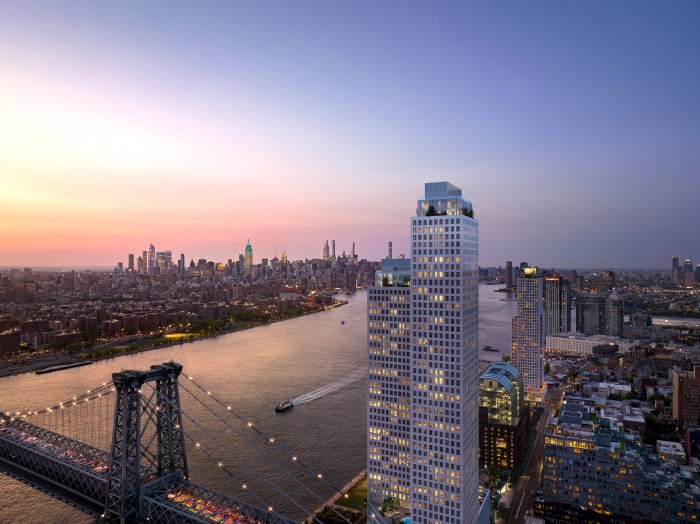
BY NATHAN DICAMILLO | Garment workers and industry leaders along with elected officials presented recommendations last Friday aimed at slowing down a proposed rezoning of the Midtown district that has been the industry’s traditional home, urging the city’s Economic Development Corporation to phase out longstanding manufacturing space preservation requirements only over time and replace them with new safeguards aimed at maintaining industry capacity.
Borough President Gale Brewer led the charge on the steps of City Hall as she pressed the EDC to review recommendations from the Garment Center Steering Committee established in May before certifying the rezoning plan it introduced earlier this year. The garment hub runs roughly from West 35th to 40th Sts., between Broadway and Ninth Ave.
“We cannot get rid of the current zoning protections for the Garment District until we are sure that enough space is preserved for the manufacturers who need to stay in Manhattan,” Brewer said.
The committee’s report included recommendations for a program aimed at retaining long-term garment production, the purchase of a building for a dedicated garment production space, support for non-profit partners of the industry, the phasing out of existing garment space preservation requirements gradually, and restrictions on hotel construction in the district. The full report can be found online at manhattanbp.nyc.gov.
Release of the report has bought critics of the rezoning plan some additional time to make their case. The city had been expected to certify the rezoning on Aug. 21, but several hours after the City Hall press conference, the EDC released a statement saying, “We have received the report released by the Manhattan Borough President’s office and look forward to a more thorough review of its recommendations. It became clear to us during the process of developing the recommendations that some were supported by all stakeholders while others were not. We’ll review the report and determine which recommendations are good policy and whether others can be adapted to support garment manufacturing and help grow good jobs for New Yorkers.”
The agency did not specify a time frame for making a final decision.
The steering committee produced its report within 90 days — which Brewer termed “unprecedented” in New York. “East Midtown took three years and we are doing this in three months,” she said. The committee talked to manufacturers, owners, and designers, while also conducting its own research.
The borough president asserted that the Manhattan Garment District plays a critical piece in the fashion industry, which across the city accounts for 180,000 jobs, $11 billion in wages, 900 fashion companies, and 75 fashion shows that give New York its status as the world’s fashion capital. “This status of privilege stands fully on the shoulders of the garment workers,” said designer Yeohlee Teng, founder of YEOHLEE, Inc.
Brewer believes the EDC and the steering committee both want to make the city’s garment rezoning plan successful and that phasing out old preservation requirements over time is the most critical recommendation in the committee’s report.

The rezoning plan announced by the EDC on March 22 would remove a 1:1 preservation requirement enacted in 1987 that requires one square foot of garment manufacturing space to be preserved for every one square foot of new office space created in the district. Despite that requirement, the Garment District has endured a steady decline in the availability of manufacturing space and a spike in hotel development. The zoning change would require new hotels to seek a special permit and is aimed at giving preference to new enterprises in the advertising, technology, media, and non-profit spheres.
The EDC reported that the nine million square feet of production space in the 1980s has shrunk to just 830,000 square feet. While more than eight million square feet of manufacturing space has disappeared since, only two percent of the original 1987 manufacturing inventory — about 175,000 square feet — has been preserved as the result of the 1:1 requirement, the EDC said.
The EDC’s goal is to allow the garment industry to retain its current footprint over the next decade while accommodating the area’s trend toward smaller companies by maintaining existing manufacturing and commercial zones but eliminating the 1:1 space preservation requirement. The EDC, in March, emphasized the garment industry’s growth in Brooklyn.
“At the beginning of this process, people were asking if we should move the Garment District to Sunset Park, Brooklyn,” Brewer said. “Obviously the answer is no, but it was the wrong question. Our real goal should be to keep garment manufacturing healthy here in Manhattan while growing it in Brooklyn and other boroughs as well.”
Brewer and others were skeptical about EDC findings that 34 percent of garment industry workers live in Brooklyn, 22 percent in Queens, 15 percent in Manhattan, and 12 percent in New Jersey. She believes that the many industry workers who have voiced unhappiness about the rezoning plan, which she points out would advantage industry growth in Brooklyn, proves the EDC wrong.
Joseph Ferrara, president of the New York Garment Center Supplier Association, argued that 80 percent of his workers travel from Queens and would have to switch from a 30-minute commute into Manhattan’s Garment District to an hour-and-45-minute commute to an emerging garment hub in Sunset Park, Brooklyn.
“Manufacturers are the most vulnerable population within the ecosystem,” Ferrara said. Removing the preservation requirements without any replacement safeguards would be removing “wholesale skills that have been honed for over a 100 years,” he added.

















